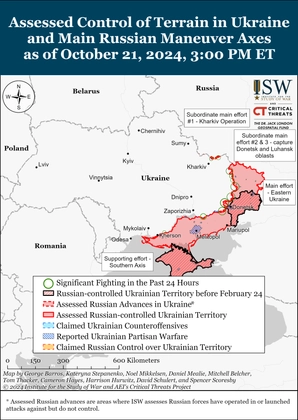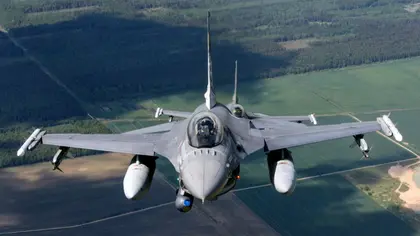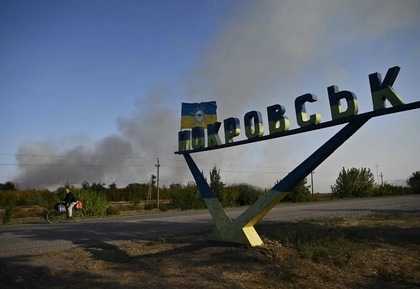On May 25, Army Gen. Mark A. Milley, the chairman of the US Joint Chiefs of Staff, stated that the US and its partners at the start of the war emphasized ground-based air defense as the best and quickest way to deny Russia air superiority over Ukraine. He argued against providing F-16 based on a cost-effectiveness analysis, which ignored some military fundamentals.
"So, you're talking about $2 billion for 10 aircraft, he said. The Russians have thousands of fourth- and fifth-generation fighters. So, if you're going to contest Russia in the air, you're going to need a substantial amount of fourth- and fifth-generation fighters. If you look at the cost curve and do the analysis, the smartest thing to have done is exactly what we did do, which is provide a significant amount of integrated air defense to cover the battlespace and deny the Russians the airspace. And that is exactly what happened."
JOIN US ON TELEGRAM
Follow our coverage of the war on the @Kyivpost_official.
Ukraine has received modern, western air defense systems like Patriot, NASAMS, IRIS-T and SAMP/T air defense systems. It has enabled Ukraine to shoot down missiles which it was previously unable to stop.
After analyzing information released by Ukraine’s Air Force, Kyiv Post found that 533 of the (at least) 563 missiles and Iranian-made Shahed drones fired against Ukraine in May were shot down. Russia conducted some 20 combined missile and drone strikes last month of which most were launched against the capitol. Overall, the kill rate by Ukraine was over 90 percent.

ISW Russian Offensive Campaign Assessment, October, 22, 2024
The airstrikes included 114 x Kh101-555 missiles - 106 destroyed, 93 percent downed; 29 x Kalibr missiles - 100 percent downed; 7 x Kinzhal missiles - 100 percent downed; 16 Iskander missiles - 100 percent downed; 5 x Kh-22 missiles - 100 percent downed; 12 x S-300 missiles - 5 destroyed, 40 percent downed; 7 x other unidentified missiles - 100 percent downed.
The results are as impressive as they are potentially misleading.
It leaves the impression that Ukraine is protected by a robust network of air defense systems but, when viewed as a whole, that’s not quite accurate. Kyiv is by far better protected than any other city, village, or settlement in Ukraine.
Firstly, as at the end of February: 89 percent of Ukraine’s air defense systems was made up of Soviet legacy systems such as the S-300 and Buk, and it is slowly running out of these missile systems. Ukraine was predicted to run out of missiles by May. Fortunately, the West has been able to help replenish some of the missiles from other users of the systems globally. Additionally, Ukraine has lost at least 113 Surface-To-Air Missile Systems since the full-scale war started.
It will take years for modern, western air defense systems to fully replace the old systems because of the number of systems needed.
This means that most cities are protected by Soviet legacy systems and are, consequently, unprotected against Russian hypersonic missiles and missiles with a ballistic trajectory. The assessment is confirmed by the Ukrainian Minister of Defense, Oleksii Reznikov, who recently stressed that:
“…. it is important to strengthen the air defense capabilities because we need to secure our sky and enable our children to go to school, students to go to universities, doctors to safely provide treatment at hospitals, etc. We must ensure a safe life for our population … it is essential to protect not only Ukraine’s capital city, Kyiv, but all big cities, such as Kharkiv, Dnipro, Odesa, Lviv, Zaporizhzhia, and others … Now we are speaking not of a principled decision regarding a certain system but of the number of those systems [to be supplied].”
Secondly, Ukrainian cities, villages, settlements, and not least, Ukrainian positions along the Russian border or frontline remain exposed to daily airstrikes. So far in June, they have been exposed to more than 884 airstrikes. During the same period, Russia lost only 1 combat aircraft and 7 helicopters. This means that the great majority of the Russian air missions are allowed to deliver their payload against Ukrainian targets before successfully returning to base.
A great number of drone strikes – including daily drone attacks along the Russian border - are probably never reported.
Consequently, several cities and villages have been totally. Almost daily there are media reports about the destruction of residential buildings and civilian casualties. The total number of damaged or destroyed private houses, apartment buildings, and dormitories, has reached an almost staggering 158,000 units. Russian destruction of schools, kindergartens, hospitals, medical facilities, energy sector facilities, businesses, and so on, comes on top of this.
Consequently, soldiers and civilians alike become casualties every day for lack of proper defense against missiles, bombs, and drones. That’s hardly a sign of a robust air defense system.
Thirdly, the Russian missile campaigns have influenced Ukraine's prioritization of the use of its scant air defense resources.
The first – but also the most comprehensive - missile campaign started on Feb. 24, 2022 focusing on mostly military objects, as well as railway junctions and fuel infrastructure. The Air Force was their number one target. Military airfields, aircraft, air defense systems, air surveillance and command and control facilities were targeted to establish Russian air supremacy over Ukraine.
“They wanted to blind us, to deprive us of means of repelling air and missile strikes. If Russia had managed to control the sky, we probably wouldn’t have our country by now. Because [controlling] the sky is key to the success of any ground operations. If we had surrendered the sky, the entire country would look like Mariupol or Bakhmut by now.” (Yurii Ihnat, spokesman for Ukraine’s Air Force, Ukrainska Pravda)
The second missile and UAV campaign started in October and targeted the energy sector. Russia tried to break Ukrainian resistance and force it to negotiate by terror, aiming to freeze out citizens, stop all functions crucial to a well-functioning society (e.g., banking, industry, heating, water, sewage, etc.) and, not least, compensate for its setbacks on the battlefield.
The current missile and UAV campaign started on April 27-28. In contrast to the fall-winter campaign, the Russians now launch from a few to several dozen missiles and drones. However, the attacks are conducted far more regularly. Around 20 attacks were launched in May alone, and mostly at night. This campaign is aimed at disrupting Ukraine’s preparations to liberate occupied territories. It is trying to destroy concentrations of equipment, troops, and ammunition.
Additionally, Russia is attempting to exhaust Ukrainian air defense systems. It is also targeting the Patriot, NASAMS, IRIS-T and SAMP/T air defense systems. If successful, Russia still has considerable untapped air power, including about 900 combat aircraft, around 120 bombers and a substantial number of helicopters, capable of fundamentally changing the course of the war to its benefit.
The problem has become more acute after Ukraine started its summer offensive operations on 4 June. Ukrainian land forces are pushing forward, entering areas where the Russian Air Force can operate with impunity. Ukrainian forces have, however, limited short-range air defense (SHORAD) to protect their units. According to US intelligence, Ukraine is running very low if it has not yet exhausted, many of its Soviet-designed surface-to-air missiles (SAM) that constitute the organic air defense of the land forces.
Among the SHORAD provided by the West, the most important include a mere 20 pieces of AN/TWQ-1 Avenger supplied by the US, which are armed with Stinger missiles and the 34 pieces of German-made Gepard self-propelled anti-aircraft gun (SPAAG).
The Russian Air Force has been constrained - to some degree - by the provision of modern Western air defense systems; however, since the start of the first phase of the Ukrainian counteroffensive, the Russian Air Force has increased dramatically its sortie rate and effectiveness.
In the article “Ukraine’s armor appears to have a Russian attack helicopter problem” (The Drive), Thomas Newdick and Tyler Rogoway argued that:
“While Russia seems to have had problems in the past with the availability of purpose-designed standoff precision-guided munitions, it has since developed more ad-hoc solutions in which Soviet-era freefall bomb designs are equipped with range-extending wing kits and, in some cases, guidance packages.
With a range of Russian fighter jets and fighter-bombers able to launch these kinds of weapons, also in significant numbers, then Ukraine is forced to move air defence systems closer to the front lines to attempt to destroy the munitions, if not the aircraft launching them.
But as soon as the radars of the Ukrainian air defense systems are activated, Russian forces respond by targeting them in turn with Lancets and other loitering munitions and drones. […] According to one pro-Russian account on the Telegram channel, “The Ukrainian defense is given no choice — if they do not shoot down Russian glide bombs, important targets are hit on the front line. If they try to shoot them down, their air defence systems can be destroyed.”
If true, then it seems that Russian field commanders may well have found an effective means of suppressing Ukrainian air defenses around the battlefield. As well as increasing the effectiveness of Russian air attacks, this in turn allows Russian aircraft, including helicopters like the Ka-52, to operate more freely near the front lines.”
Their assessments are supported by ISW.
“Russian sources are praising Russian forces’ effective use of electronic warfare (EW) systems, air support, and landmines against Ukrainian forces. Multiple Russian sources reported that Russian EW severely interfered with Ukrainian command and control signals, GPS-enabled devices, and UAV controls. Russian sources reported that Ukrainian forces had insufficient air defense in the Orikhiv sector, that Russian forces operated with an unprecedented amount of rotary wing air support, and that Russian aviation was able to return to a high level of activity after not actively engaging in combat operations since the beginning of the full-scale invasion in 2022.”
According to British Defence Intelligence, Russia has strengthened its attack helicopter force in the region. Imagery shows that over 20 extra Russian helicopters deployed to Berdyansk Airport, approximately 100 km behind the front line. Russia might have gained a temporary advantage in southern Ukraine, especially with attack helicopters employing longer-range missiles against ground targets. Russian bloggers increasingly highlight the successes of the combat helicopters and there are unconfirmed reports of dozens of Ukrainian armored vehicles being destroyed in recent fighting.
This critical vulnerability will continue to impact both the ongoing counteroffensive and the safety of its civilian population. Therefore, Ukraine might be forced to temporarily pause counteroffensive operations to better counter the increased air threat along the frontline. Ukraine has not yet committed the majority of its available forces to counteroffensive operations and has not yet launched its main effort. It makes no sense to push forward before the land forces are properly protected from the air.
As a consequence of the limited availability of mobile SHORAD systems to support the counteroffensive, Ukraine might need to deploy Patriot, IRIS-T and NASAMS air defense to high-threat areas to ensure success on the battlefield (and preserve its land forces). If so, this could come at an increased risk for its citizens and critical infrastructure. It might also explain why Ukraine has downed 4 helicopters in the last 3 days.
Denmark, the Netherlands, the UK, and the United States have, however, recently united to strengthen Ukraine’s air defense capabilities.
In a joint statement released by their respective defense ministries, the countries have declared their commitment to urgently supply high-priority air defense equipment to Ukraine. The equipment which will be delivered includes hundreds of short and medium-range air defense missiles and associated systems required to protect Ukraine’s critical national infrastructure. The initiative also intends to ensure Ukrainian success in the forthcoming counteroffensive. Delivery of the equipment has already begun and should be complete within the next few weeks.
While the initiative is crucially important, it will not solve the fundamental challenge of Air Control.
According to the US Air Force, Airspace Control must inherently be a joint effort across all domains (Land, Maritime and Air). Airspace control is required to enhance air and missile defense; facilitate joint fire plans; enhance and support movement, maneuver, and employment of land component forces, conduct fleet defense and project power from naval surface forces; maximize the effectiveness of operations conducted in, from, and through the air; and integrate and synchronize all-domain operations to create synergistic effects and achieve Joint Forces Commander’s objectives.
Ukraine is unable to achieve most of the effects described above due to the continued lack of modern, western-made ground-based air defense and combat aircraft.
Its Allies have repeatedly stressed that they prioritize GBAD before F-16. Prioritization, however, does not mean they are providing Ukraine with enough GBAD to defend all major cities, critical infrastructure, frontline settlements, and Ukrainian positions, or not least, the units trying to liberate occupied territories.
Ukraine has repeatedly stressed that they are not receiving enough means to close the sky. The decision to supply Ukraine with F-16 is, therefore, crucially important.
It will make a huge impact. In 6-12 months.
Western intervention is the only credible way to protect Ukraine and its counteroffensive from Russian air power.
The cry for NATO to close the sky over Ukraine has never stopped. It has only grown hoarse.
Hans Petter Midttun, Independent Analyst, Hybrid Warfare, Non-resident Fellow at Centre for Defence Strategies, board member Ukrainian Institute for Security and Law of the Sea, former Defence Attaché of Norway to Ukraine, and Officer (R) of the Norwegian Armed Forces.
The views expressed in this opinion article are the author’s and not necessarily those of Kyiv Post.
You can also highlight the text and press Ctrl + Enter






